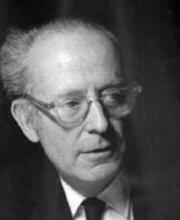Ernst Kitzinger

Ernst Kitzinger (December 27, 1912 – January 22, 2003) was a German-American historian of late antique, early medieval, and Byzantine art.
Kitzinger entered the University of Munich in 1931, where he studied the history of art, principally under Wilhelm Pinder. From the summer of 1931 on, Kitzinger spent significant time in Rome, enrolled in the University of Rome, and intellectually centered at the Bibliotheca Hertziana. The beginning of the Nazi regime in 1933 raised the immediate possibility that Jewish students might be banned from receiving degrees. Kitzinger accordingly completed his dissertation, a brief but influential study of Roman painting in the 7th and 8th centuries, with exceptional speed, and defended it in the fall of 1934. He left Germany the day after his thesis defense.
Kitzinger first returned to Rome, before moving on to England, where he found volunteer employment at the British Museum. Among a wide range of art-historical interests, he quickly developed a particular focus on Anglo-Saxon art through being enlisted by T. D. Kendrick to assist in a comprehensive survey of surviving pre-Norman stone sculpture in England. Kitzinger's first published article was on Anglo-Saxon vinescroll ornament; he also contributed to the assessment of the then-recently unearthed treasures of the Sutton Hoo Ship Burial in 1939. In 1937, on a modest grant from a patron of the British Museum, he traveled to Egypt and Istanbul, further widening his perspective on late antique and early medieval art as an "international" phenomenon. It was this perspective that he brought to his first book, Early Medieval Art in the British Museum (1940).
In 1941 Kitzinger became a Junior Fellow at Dumbarton Oaks. Once there, Kitzinger was assigned by Wilhelm Koehler to a systematic study of the Byzantine monuments of the Balkans (leading to an important article on the monuments of Stobi (1946)). Several years later, Kitzinger began work on a complete survey of the mosaics of Norman Sicily. This project would occupy him for the rest of his life, resulting in multiple publications: The Mosaics of the Capella Palatina in Palermo: An Essay on the Choice and Arrangement of Subjects [Art Bulletin 31 (1949): 269–292], The Mosaics of Monreale [Palermo: S. F. Flaccovio Editore (1960) (republished, 1991, with a new preface, Italian only)], The Mosaics of St. Mary's of the Admiral in Palermo [Washington, D.C.: Dumbarton Oaks Studies (1990)], and the six-volume corpus of photographs of the mosaics, I mosaici del periodo normanno in Sicilia (1992–1995). These monographs were regarded by Kitzinger as his greatest accomplishment, laying the foundation for all future study of these monuments that, like his own work, occupied a middle ground between East and West.
Kitzinger quickly advanced through the ranks at Dumbarton Oaks, becoming an Assistant Professor in 1946, Associate Professor in 1951, Director of Studies in 1955, and Professor of Byzantine Art and Archaeology in 1956. As Director of Studies, he firmly established Dumbarton Oaks as an academic institution of international renown and the world's leading institution for Byzantine studies.
Kitzinger resigned as director of studies at Dumbarton Oaks in 1966, accepting a position as the Arthur Kingsley Porter University Professor at Harvard, which he held until his retirement in 1979. At Harvard, Kitzinger supervised eighteen doctoral dissertations. Among his distinguished students over his years of teaching and mentoring are Hans Belting, Madeline Caviness, Joseph Connors, Anna Gonosova, Christine Kondoleon, Irving Lavin, Henry Maguire, John Mitchell, Lawrence Nees, Nancy Netzer, Natasha Staller, James Trilling, Rebecca Corrie, and William Tronzo.
